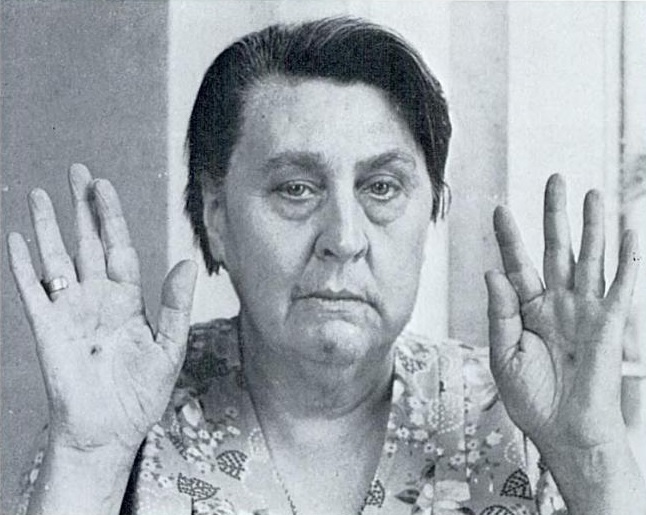
Ethel Chapman

Above photo is of Ethel Chapman with stigmata visible on the palms of her hands.
The phenomenon of stigmatization was studied in the case of British subject Ethel Chapman. A victim of multiple sclerosis, Chapman was paralyzed from the waist down. She was unable to hold things in her hands. Chapman was a patient at the Cheshire Home in Britain, where she was interviewed by geriatrician Dr. Colin Powell, who found no indication of depression, neurosis, or psychosis. There was also no indication of the condition known as dermatitis artifacta, when subjects scratch or otherwise harm themselves for various reasons. Chapman appeared friendly, mentally stable, and far from gaining any psychological advantage from stigmata, she found it a burden. Various witnesses testified to seeing wounds on Chapman’s hands and feet on Good Friday.In a BBC radio interview in 1973, Chapman gave a description of her first vision and sensations in the following words: ‘‘I remember saying quite plainly ‘Oh Lord, please show me in some way you’re there.’ In the early hours of the morning, I thought it was a dream. I felt myself being drawn on to the Cross. I felt the pain of the nails through my hands and through my feet. I could see the crowds, all jeering and shouting and, of course, it was in a foreign language, I don’t know what they were saying. I felt myself all the agony and all the pain that the Lord Himself went through. . . .’’ Chapman also claimed that on occasions she had been lifted up in the air and smelled supernatural sweet perfumes. Witnesses affirmed seeing fresh blood on Chapman’s hands on Good Friday and it is believed that Chapman was unable to inflict the wounds herself due to her paralysis. Chapman, like some other stigmatics, seemed to regard the phenomenon as a mark of divine love due to her illness. Word spread about Chapman’s stigmata and people wrote asking for her help or healing. She regularly devoted time to prayers on behalf of the afflicted. |